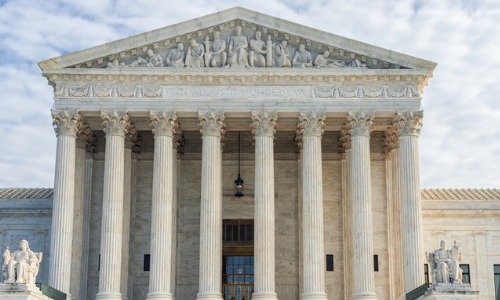The Supreme Court’s Code of Ethics and the Road Ahead
 Last month, for the first time in history, the U.S. Supreme Court adopted a code of ethics. The code specifies that justices should uphold the integrity and independence of the judiciary; avoid impropriety and the appearance of impropriety; perform their duties fairly, impartially, and diligently; engage in extrajudicial activities that are consistent with the obligations of the judicial office; and refrain from political activity. This followed a period of growing concern and public scrutiny over the ethical standards governing the Court’s justices. While the justices maintain that this code is simply a codification of existing practices, such codification marks a step in the right direction when it comes to the Court’s transparency restoring public trust and confidence in the judiciary.
Last month, for the first time in history, the U.S. Supreme Court adopted a code of ethics. The code specifies that justices should uphold the integrity and independence of the judiciary; avoid impropriety and the appearance of impropriety; perform their duties fairly, impartially, and diligently; engage in extrajudicial activities that are consistent with the obligations of the judicial office; and refrain from political activity. This followed a period of growing concern and public scrutiny over the ethical standards governing the Court’s justices. While the justices maintain that this code is simply a codification of existing practices, such codification marks a step in the right direction when it comes to the Court’s transparency restoring public trust and confidence in the judiciary.
Prior to this change, the Supreme Court was the only court in the U.S. federal judiciary not bound by a specific code of conduct. This lack of a formal ethical code led to increased scrutiny, especially in cases where the justices’ conduct or potential conflicts of interest raised questions about their independence, impartiality, and political neutrality. High-profile cases and individual justices’ actions further propelled the debate, highlighting the need for clear ethical guidelines to maintain public trust and the integrity of the Court.
IAALS’ research underscores the importance of addressing these concerns. For example, IAALS’ O’Connor Judicial Selection Plan consulted with various legal system stakeholders to identify desirable core values in judges, finding individual judges must be “fundamentally fair and impartial,” must have “decisional independence,” must “not engage in partisan politics,” and must eschew not only actual bias but even the mere “appearance of bias.” Failure to abide by these standards “threatens independent decision making and erodes public confidence in the judicial system.”
This is supported by the research in IAALS’ 2020 publication Public Perspectives on Trust and Confidence in the Courts. Respondents had largely negative views of the Supreme Court because they believe the Court has been overly politicized. Those who expressed distrust of the judiciary more broadly often referenced perceptions of judicial bias, specifically bias toward a particular political affiliation. This erosion of trust extends to the Supreme Court itself, as evidenced by a recent Gallup poll where fewer than half of Americans expressed “a great deal” or a “fair amount” of trust and confidence in the institution.
The decision to adopt a code of ethics was seen as a response to these concerns, aiming to align the Supreme Court with the ethical standards expected in other federal courts and to bolster the judiciary’s reputation for impartiality and fairness. Yet while it’s a great sign that the court has decided to begin adopting a code of ethics, the recently adopted code of ethics for the U.S. Supreme Court has drawn several critiques.
- No external enforcement mechanism: Critics note that the ethics policy primarily relies on self-enforcement by the justices, lacking the robust enforcement mechanisms some advocates and scholars had proposed. There’s currently no provision for oversight by lower-court judges or an independent monitor to ensure compliance. This does little to address the deficit in public confidence, as many do not trust the Supreme Court to effectively police its own behavior.
- Vagueness and generality: The code, which mirrors existing rules for lower court judges with some specific provisions for the Supreme Court, has also been criticized for being vague. It advises justices to avoid actions where their impartiality might be questioned and to limit political activities, but these guidelines are broadly stated and do not clearly define what those actions might be.
- Reflection of existing practices: The Court stated that the code largely reflects its longstanding practices, which some critics may view as insufficiently safeguarding against ethical breaches. This suggests the code might not significantly change the justices’ conduct but rather formalizes existing norms that many members of the public view as failing to hold Justices accountable to important ethical standards.
- Controversies leading to the code's adoption: The adoption of the code followed controversies involving Justices Clarence Thomas and Samuel Alito, who faced allegations of ethical lapses such as unreported luxury travel. This background has fueled debate over whether the new code adequately addresses such issues.
Crafting a code of ethics beyond critique is an impossible task. Yet the public needs to be able to trust that a code will protect against real or perceived biases and conflicts of interest among justices who are making extremely consequential decisions that impact the lives of all Americans. IAALS’ work in the areas of judicial ethics and discipline underscores this. According to our Recommendations for Judicial Discipline Systems, the public needs to know that judicial ethics and violations of any applicable codes are taken seriously. “Absent that assurance, the system appears self-serving, protectionist, and even potentially corrupt.” For this reason, even the strongest code of ethics will not suffice if it lacks a strong, external enforcement and oversight mechanism.
Courts cannot function unless the public have faith that they are acting impartially and with moral integrity, and it is crucial to have robust and enforceable safeguards in place to ensure this is happening.



